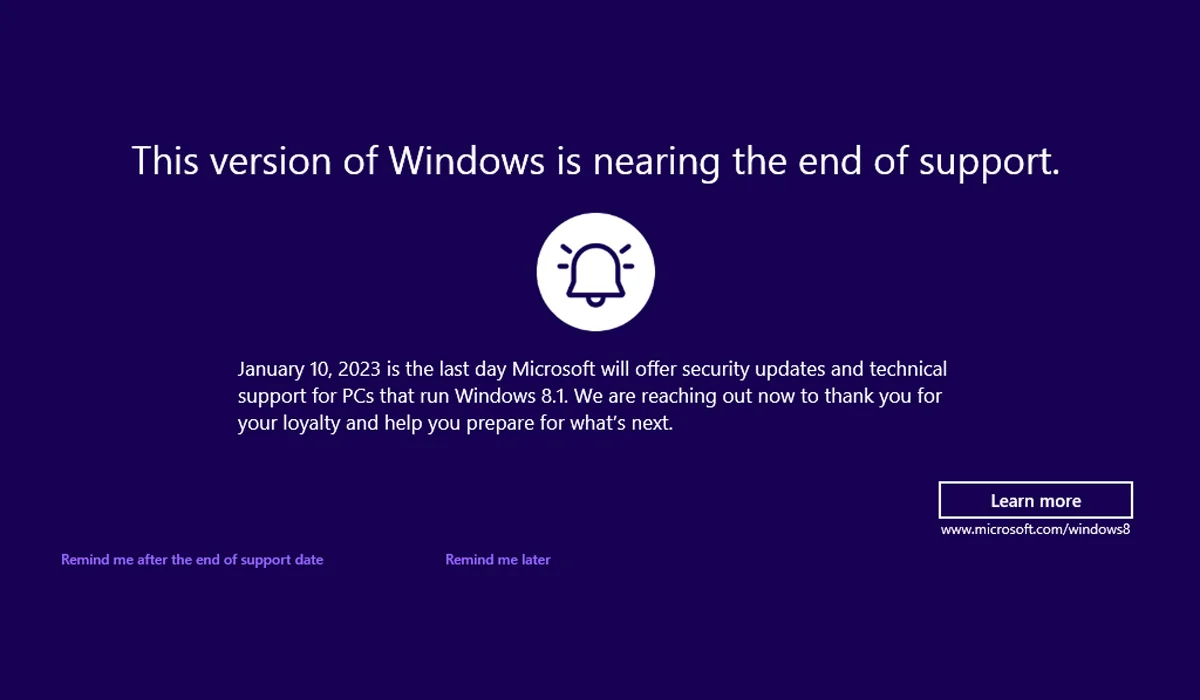First, it’s important to understand that Microsoft ended support for Windows 8.1 on January 9th, 2018. This means that the operating system will no longer receive security updates, bug fixes, or technical support from Microsoft. While users can still continue to use Windows 8.1, it’s important to note that their devices will become increasingly vulnerable to security threats and other issues.
The End of Era: Saying Goodbye!
Windows 8.1 was first released in 2013 and was meant to be a modern and touch-friendly version of Windows. It featured a new interface and a range of new features, such as the ability to sync settings across devices and the integration of Microsoft’s virtual assistant, Cortana. However, despite these improvements, Windows 8.1 never really caught on with users, and many found the interface confusing and difficult to navigate.
On January 9th, 2018, Microsoft officially ended support for Windows 8.1, marking the end of an era for the operating system. This means that the operating system will no longer receive security updates, bug fixes, or technical support from Microsoft. While users can still continue to use Windows 8.1, it’s important to note that their devices will become increasingly vulnerable to security threats and other issues.

For users who are still using Windows 8.1, it’s time to start thinking about upgrading to a newer operating system. The most obvious solution is to upgrade to Windows 10, which has been much more successful and widely adopted. Not only will users be able to take advantage of the latest features and improvements, but they’ll also receive ongoing support and security updates. Upgrading to Windows 10 is a straightforward process and can be done through the Microsoft website.
Why It’s Time to Upgrade
The end of support for Windows 8.1 means that users who continue to use the operating system will no longer receive security updates, bug fixes, or technical support from Microsoft. This leaves devices vulnerable to security threats and other issues, which could compromise the safety of personal information and sensitive data.
Upgrading to a newer operating system, such as Windows 10, is the best course of action for users who want to ensure the security and longevity of their devices. Windows 10 offers a range of new features and improvements, including a more streamlined and user-friendly interface, enhanced security features, and better performance overall. In addition, Windows 10 is designed to work seamlessly across devices, making it easier to access and share files and information.
Another reason why it’s time to upgrade from Windows 8.1 is the need to keep up with the latest software and applications. As technology continues to evolve, older operating systems like Windows 8.1 may not be compatible with new software and applications. By upgrading to Windows 10, users can take advantage of the latest software and applications and ensure that their devices are running at peak performance.
The Risks of Continuing to Use Windows 8.1
Continuing to use an unsupported operating system like Windows 8.1 can expose users to a range of security risks. Without security updates and patches, devices running Windows 8.1 are vulnerable to malware, viruses, and other online threats. Cybercriminals are constantly looking for vulnerabilities to exploit, and an unsupported operating system is an easy target.
In addition to security risks, continuing to use Windows 8.1 can also lead to performance issues and compatibility problems with newer software and applications. As technology advances, older operating systems may not be able to keep up, leading to slower performance and decreased productivity. This can be especially problematic for businesses and organizations that rely on technology to operate efficiently.
Furthermore, using an outdated operating system can be costly in the long run. Without ongoing support and updates, devices running Windows 8.1 may experience more frequent issues and require more repairs and maintenance. This can lead to increased costs for businesses and individuals alike. Upgrading to a newer operating system like Windows 10 can help avoid these costs and ensure that devices are running smoothly and efficiently.
The Importance of Staying Current with Operating Systems: Windows 8.1 End of Life
The end of life for Windows 8.1 serves as a reminder of the importance of staying current with operating systems. Operating systems are the backbone of any computer or device, and they provide the foundation for all software and applications. When an operating system reaches its end of life, it means that it will no longer receive security updates, bug fixes, or technical support from the manufacturer. This leaves devices vulnerable to security threats and other issues.
Staying current with operating systems is crucial for maintaining the security and longevity of devices. By upgrading to a newer operating system, users can take advantage of the latest features and improvements, as well as ongoing support and security updates. This ensures that devices are protected from the latest threats and are running at peak performance.
In addition to security and performance benefits, staying current with operating systems can also help users stay ahead of the curve in terms of technology and innovation. Newer operating systems often introduce new features and functionalities, which can help users work more efficiently and productively. By staying current with operating systems, users can ensure that they are taking advantage of the latest technology and staying competitive in their fields.





